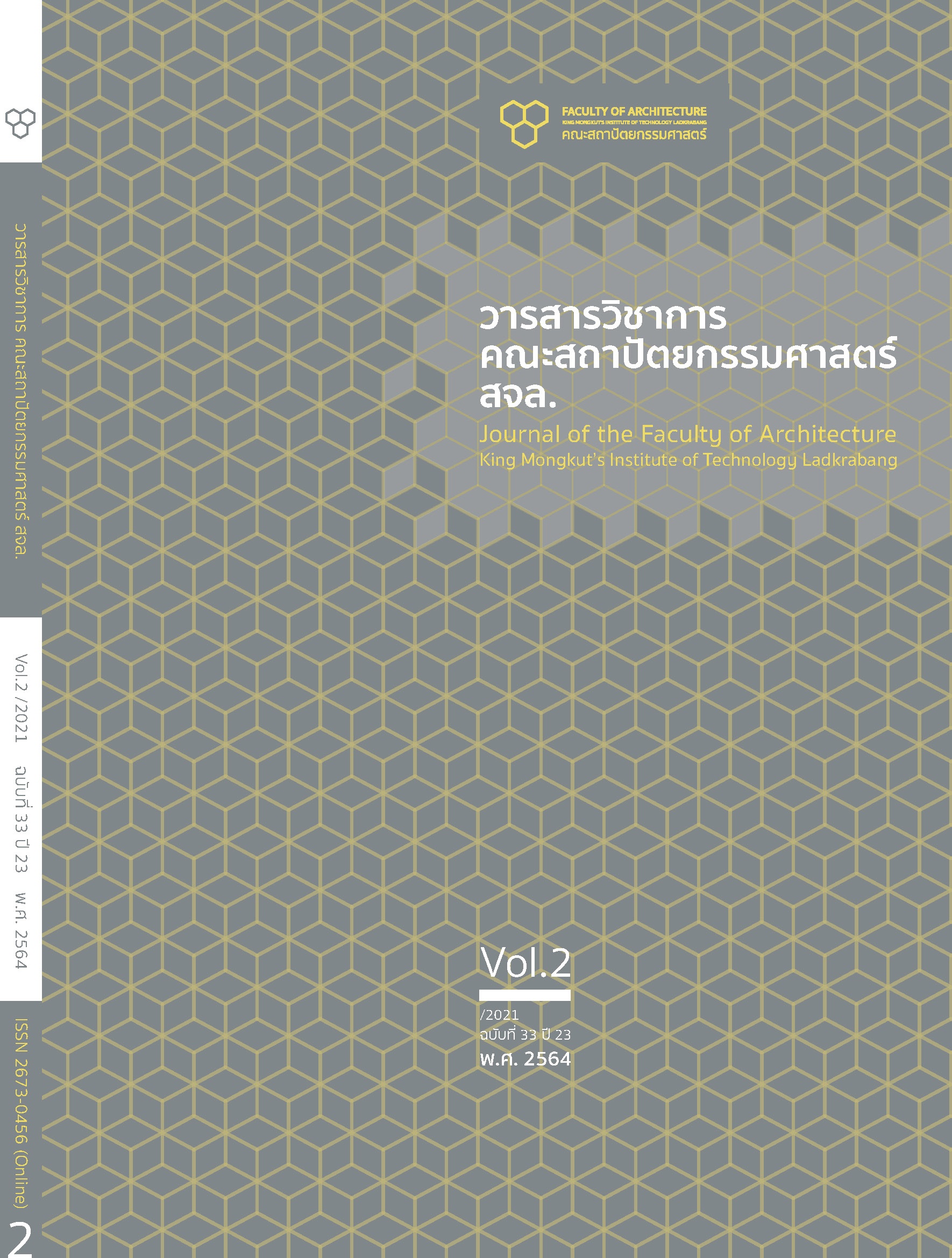Coffee Shop as a Creative Tool for The District to Promote Tourism
Main Article Content
Abstract
The purpose of this paper is to identify trends and suggest criteria for urban development from coffee shops and coffee shop design for urban liveliness. Literature review was done by reviewing their characteristics as a public space that attracts users and respond to new lifestyles, the relationship between coffee shops and cities and tourism trends. Case studies in this research were analyzed from café tourism development around the world: 1) Cuba Street, Wellington, New Zealand; 2) Coffee shop in Australia; 3) Gangneung Coffee Street, South Korea; 4) Fujin Street, Taipei, Taiwan; 5) Nakameguro, Tokyo, Japan and 6) Sidewalk Café, Paris, France.
As a result, there are three interesting issues: 1) architectural design level - designing the ground floor for interaction between inside and outside, adding architectural values, and focusing on interior design and façade decoration. 2) Urban design level – designing urban environment and green spaces to encourage pedestrian traffic, opportunities for creative district development, and adding real estate value. 3) Tourism policy level - implementation to assist tourism organizations that respond to human behavior.
Article Details

This work is licensed under a Creative Commons Attribution-NonCommercial-NoDerivatives 4.0 International License.
This work is licensed under a Creative Commons Attribution-NonCommercial-ShareAlike 4.0 International License.
Copyright Transfer Statement
The copyright of this article is transferred to Journal of The Faculty of Architecture King Mongkut's Institute of Technology Ladkrabang with effect if and when the article is accepted for publication. The copyright transfer covers the exclusive right to reproduce and distribute the article, including reprints, translations, photographic reproductions, electronic form (offline, online) or any other reproductions of similar nature.
The author warrants that this contribution is original and that he/she has full power to make this grant. The author signs for and accepts responsibility for releasing this material on behalf of any and all co-authors.
References
เกียรติกร พันวา. (2557). การศึกษารูปแบบวัฒนธรรมกาแฟ ในเขตเทศบาลนครขอนแก่นเพื่อส่งเสริมการท่องเที่ยวรูปแบบเมือง (ปริญญาบริหารธุรกิจมหาบัณฑิต สาขาวิชาการจัดการการท่องเที่ยว คณะวิทยาการจัดการ มหาวิทยาลัยขอนแก่น).
นันท์นภัส ยชนาโชติทรัพย์. (2562). ธุรกิจร้านกาแฟในเกาหลีใต้. เข้าถึงได้จาก: https://www.ditp.go.th/contents_attach/577646/577646.pdf
ทวิช พงศกรวสุ และเจริญชัย เอกมาไพศาล. (2560). การศึกษารูปแบบการตลาดบริการของร้านกาแฟสไตล์บูทีค: กรณีศึกษา เขตอำเภอเมือง จังหวัดเชียงใหม่. วารสารปัญญาภิวัฒน์. 9(3), 107-119.
ใบเฟิร์น แก้วจำปาสี. (2562). ปัจจัยที่ส่งผลต่อการบริโภคกาแฟสด ในอำเภอเมือง จังหวัดราชบุรี. วารสารนวัตกรมการบริหารและการจัดการ มหาวิทยาลัยเทคโนโลยีราชมงคลรัตนโกสินทร์. 7(3), 89-106.
บุญสม โชติรัตน์. (2563). ปัจจัยแห่งความสำเร็จของธุรกิจร้านกาแฟ อินดี้ ในเขตภาพกลางตอนล่างของประเทศไทย. วารสารมนุษยศาสตร์และสังคมศาสตร์ มหาวิทยาลัยธนบุรี. 15(2), 137-149.
ลิลลี่ กิตติศรีกังวล. (2559). Fujin Street ถนนสายฮิปสเตอร์ที่สวยที่สุดในไทเป. เข้าถึงได้จาก: https://www.soimilk.com/travel/news/slow-life-on-fujin-street-taipei
เอกศาสตร์ สรรพช่าง. (2560). ส่องดูเทรนด์กาแฟปีนี้ (1) เข้าถึงได้จาก: https://www.posttoday.com/economy/news/476678
อภิชญา โออินทร์ (17 พฤษภาคม 2561). สุมหัวกันในที่ที่สาม: กระบวนการตามหาชุมชนทางวัฒนธรรมของคนรุ่นใหม่ในเมืองตรัง. เข้าถึงได้จาก: https://medium.com/intermingle-in-trang/โครงการวิจัย-สุมหัวกันในที่ที่สาม-กระบวนการตามหาชุมชนทางวัฒนธรรมของคนรุ่นใหม่ในเมืองตรัง-b437cbc3b8e6
Gee. (2561). 5 แนวคิดสร้างสรรค์เปลี่ยนไทเป ให้กลายเป็นเมืองสีเขียว. เข้าถึงได้จาก: https://dsignsomething.com/2018/01/24/5-แนวคิดสร้างสรรค์-เปลี่/
Boontharm, D. (2015). Creative Milieux of Fashion and Reuse in Tokyo, Bangkok and Singapore. Journal of Urban Design, 20(1), 75-92.
Brunt, S. (2010). Sounding out the streets: Performance, Cultural identity and Place in Wellington’s Cuba street carnival. Many Voices: Music and National Identity in Aotearoa/New Zealand, pp.39-49, Cambridge Scholars Publishing, United Kingdom.
Brunhuber, K. (2018). A Stroll Down Coffee Street in Coffee City: South Korea’s java obsession. Retrieved from: https://www.cbc.ca/news/world/coffee-street-south-korea-olympics-1.4529750
Chiang, K. (2017). 5 Best Taipei Cafes selected by Fujin Tree Group representative Jay Wu. Retrieved from: https://www.herenow.city/en/taipei/article/five-taipei-cafe/
Chadios, K. (2005). The Urban Coffee Shop. (Master of Science in Architecture Studies, Massachusetts Institute of Technology).
Coffee BI, (2019). The South Korean Coffee Market, One of Leading Market in the World. Retrieved from: https://coffeebi.com/2019/03/13/south-korean-coffee-market/
Cui, T. (2019). Smell of Cuba Street: Mapping Smells to Understand a Place. (Master of Design, Massey University).
DesForges, J. (16 April 2019). Everything you want to know about the café terraces in Paris. Retrieved form: https://www.parisperfect.com/blog/2019/04/cafe-terraces-in-paris/
El Attar, M. (2016). The Emergence of Sidewalk Café in El Korba, Heliopolis. Retrieved from: https://www.academia.edu/9465816/The_Emergence_of_Sidewalk_Caf%C3%A9s_in_El_Korba_Heliopolis
Gehl, J. (September 2010). Cities for People. Washington DC: Island Press.
Green, P. (2016). Public-Private Spaces: How Cafes Could Inspire Place Branding. Retrieved from: https://placebrandobserver.com/how-cafes-could-inspire-place-branding/.
Haine, S. W. (1998). The world of the Paris Café: Sociability among the French Working Class, 1789-1914. Maryland: Johns Hopkins University Press.
Hall, C. M., Tipler, J., Reddy, R., and Rowling, K.. (2010). Coffee Servicescapes: The Design of Café Culture in New Zealand. Coffee Culture, Destinations and Tourism, 23-40.
Kastner, J. (2010). The Taipei Area Designed according to United Nations Recommendations. Retrieved from: https://taiwanreports.wordpress.com/older-reports-in-english/the-taipei-area-designed-according-to-united-nations-recommendations/
Li, S. (2018). Fujin Tree- The Path to the Far-reaching Future. Retrieved from: https://journal.the-readymade.com/post/173988266304/jay-wu-founder-of-fujin-tree-group-fujin
Lukito, Y., Xenia, P, A. (December 2017). Café as Third Place and The Creation of a Unique Space of Interaction in UI Campus. Retrieved from: https://www.researchgate.net/publication/322281475_Cafe_as_third_place_and_the_creation_of_a_unique_space_of_interaction_in_UI_Campus
Méheut, C. (11 March 2020). In Paris, Café Terraces Are an Environmental Battleground. The New York Times. Retrieved from: https://www.nytimes.com/2020/03/11/world/europe/paris-terraces-climate-change.html
Moore, T. (2017). Flat white urbanism: there must be better ways to foster a vibrant street life. Retrieved from: https://theconversation.com/flat-white-urbanism-there-must-be-better-ways-to-foster-a-vibrant-street-life-78338
Moretti, R. (2017). A Comparative Study of Coffee Culture between Italy and South Korea: An Exploratory Study. Retrieved from: https://www.koreascience.or.kr/article/JAKO201712965729481.pdf
Oldenburg, R. (1990). The Great Good Place. New York: Da Capo Press.
Sullivan, O. F. (2021). Paris Will Keep Its Covid-Era Café Terraces. Retrieved from: https://www.bloomberg.com/news/articles/2021-06-15/paris-will-keep-its-covid-era-cafe-terraces
Schembri, S., Ellingsen, M. (2013). Postmodern Cultural Complexities: the Two Worlds on Cuba Street. Retrieved from: https://www.acrwebsite.org/volumes/1014499/volumes/v41/NA-41
Seo, U. (2019). Coffee tourism as creative tourism: implications from Gangneung’s experiences, A Research Agenda for Creative Tourism. Cheltenham: Edward Elgar.
Tokyo Convention & Visitor Bureau. (2019) Nagameguro Tree tunnels, bars and bookstores-the sophisticated side of the city. Retrieved from: https://www.gotokyo.org/en/destinations/southern-tokyo/nakameguro/index.html
Tourism Australia. (2021). Coffee O’ Clock in Australia. Retrieved from: https://www.australia.com/en-my/things-to-do/food-and-drinks/coffee-o-clock-in-australia.html Tourism Bureau, Republic of China (Taiwan). (2020). A Shopper’s Guide to Taiwan. Retrieved from: https://eng.taiwan.net.tw/att/files/%E5%8F%B0%E7%81%A3%E6%97%85%E9%81%8A%E6%8C%87%E5%8D%97_%E8%8B%B1%E6%96%87%E7%89%88_%E6%91%BA%E9%A0%81_%E8%B3%BC%E7%89%A9.pdf
Weaver, A. (2019). Café Culture and Conservation: Tourism and Urban(e) Experiences in Wellington, New Zealand, Coffee Culture, Destinations and Tourism. New York: Channel View Publications.


